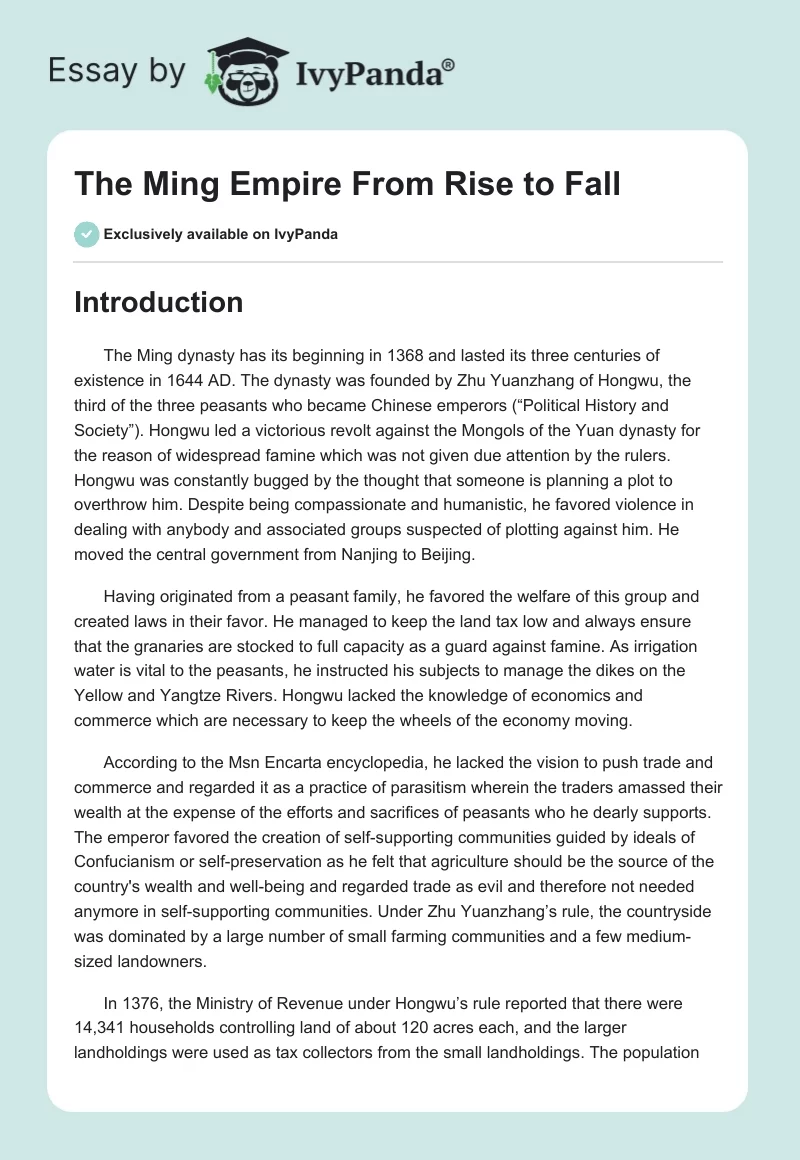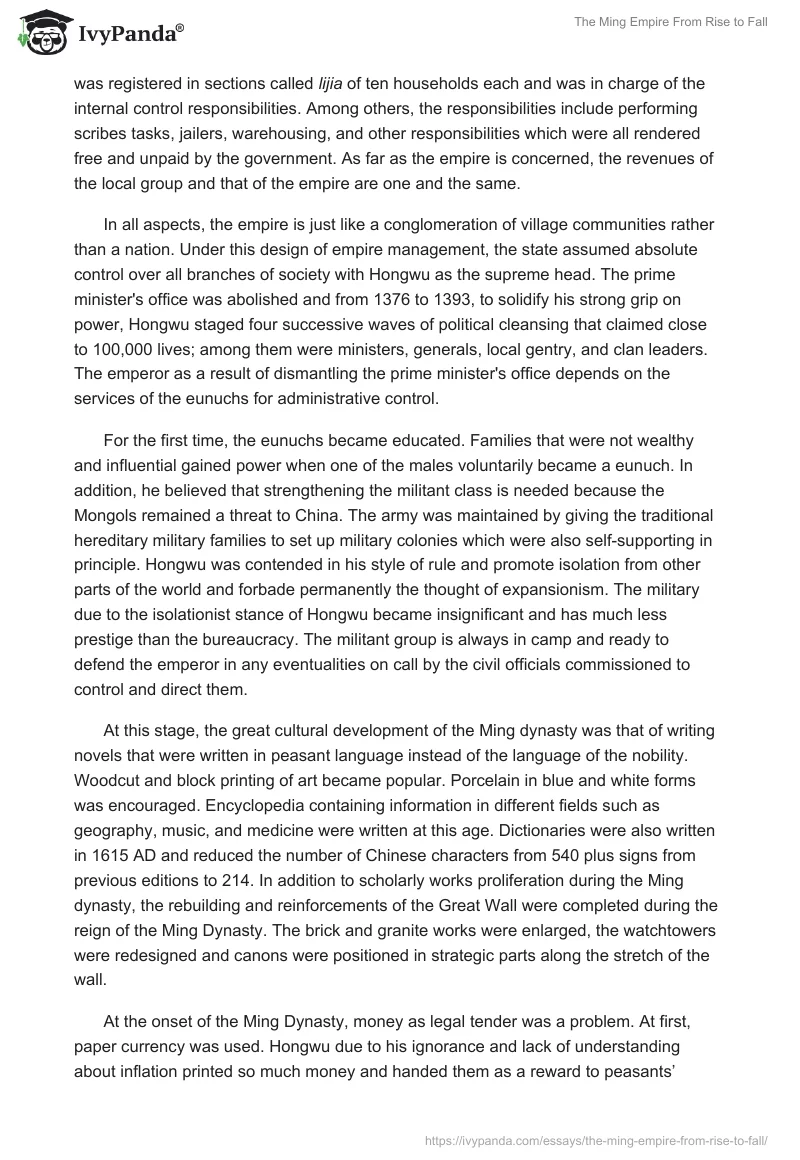Introduction
The Ming dynasty has its beginning in 1368 and lasted its three centuries of existence in 1644 AD. The dynasty was founded by Zhu Yuanzhang of Hongwu, the third of the three peasants who became Chinese emperors (“Political History and Society”). Hongwu led a victorious revolt against the Mongols of the Yuan dynasty for the reason of widespread famine which was not given due attention by the rulers. Hongwu was constantly bugged by the thought that someone is planning a plot to overthrow him. Despite being compassionate and humanistic, he favored violence in dealing with anybody and associated groups suspected of plotting against him. He moved the central government from Nanjing to Beijing.
Having originated from a peasant family, he favored the welfare of this group and created laws in their favor. He managed to keep the land tax low and always ensure that the granaries are stocked to full capacity as a guard against famine. As irrigation water is vital to the peasants, he instructed his subjects to manage the dikes on the Yellow and Yangtze Rivers. Hongwu lacked the knowledge of economics and commerce which are necessary to keep the wheels of the economy moving.
According to the Msn Encarta encyclopedia, he lacked the vision to push trade and commerce and regarded it as a practice of parasitism wherein the traders amassed their wealth at the expense of the efforts and sacrifices of peasants who he dearly supports. The emperor favored the creation of self-supporting communities guided by ideals of Confucianism or self-preservation as he felt that agriculture should be the source of the country’s wealth and well-being and regarded trade as evil and therefore not needed anymore in self-supporting communities. Under Zhu Yuanzhang’s rule, the countryside was dominated by a large number of small farming communities and a few medium-sized landowners.
In 1376, the Ministry of Revenue under Hongwu’s rule reported that there were 14,341 households controlling land of about 120 acres each, and the larger landholdings were used as tax collectors from the small landholdings. The population was registered in sections called lijia of ten households each and was in charge of the internal control responsibilities. Among others, the responsibilities include performing scribes tasks, jailers, warehousing, and other responsibilities which were all rendered free and unpaid by the government. As far as the empire is concerned, the revenues of the local group and that of the empire are one and the same.
In all aspects, the empire is just like a conglomeration of village communities rather than a nation. Under this design of empire management, the state assumed absolute control over all branches of society with Hongwu as the supreme head. The prime minister’s office was abolished and from 1376 to 1393, to solidify his strong grip on power, Hongwu staged four successive waves of political cleansing that claimed close to 100,000 lives; among them were ministers, generals, local gentry, and clan leaders. The emperor as a result of dismantling the prime minister’s office depends on the services of the eunuchs for administrative control.
For the first time, the eunuchs became educated. Families that were not wealthy and influential gained power when one of the males voluntarily became a eunuch. In addition, he believed that strengthening the militant class is needed because the Mongols remained a threat to China. The army was maintained by giving the traditional hereditary military families to set up military colonies which were also self-supporting in principle. Hongwu was contended in his style of rule and promote isolation from other parts of the world and forbade permanently the thought of expansionism. The military due to the isolationist stance of Hongwu became insignificant and has much less prestige than the bureaucracy. The militant group is always in camp and ready to defend the emperor in any eventualities on call by the civil officials commissioned to control and direct them.
At this stage, the great cultural development of the Ming dynasty was that of writing novels that were written in peasant language instead of the language of the nobility. Woodcut and block printing of art became popular. Porcelain in blue and white forms was encouraged. Encyclopedia containing information in different fields such as geography, music, and medicine were written at this age. Dictionaries were also written in 1615 AD and reduced the number of Chinese characters from 540 plus signs from previous editions to 214. In addition to scholarly works proliferation during the Ming dynasty, the rebuilding and reinforcements of the Great Wall were completed during the reign of the Ming Dynasty. The brick and granite works were enlarged, the watchtowers were redesigned and canons were positioned in strategic parts along the stretch of the wall.
At the onset of the Ming Dynasty, money as legal tender was a problem. At first, paper currency was used. Hongwu due to his ignorance and lack of understanding about inflation printed so much money and handed them as a reward to peasants’ organizations. By 1425 AD, the currency was worth 1/70 of its original value. This led to the use of copper coins but the government was not able to mint enough coins and counterfeiting ensued. To solve the lack of coins, the provinces were ordered to mint their own coins but a number of them added lead resulting in depletion of its value. The demand for the coin was amplified by the increasing need for money to support the growth of trade.
Although trade and commerce, in general, were looked down upon, China through the efforts of Zheng, a son of Hongwu established sea routes used for trade with Japan and South Asia. Starting in 1405, Zheng began a series of seven naval expeditions that went as far as the east coast of Africa and were mainly diplomatic in nature. China became ahead of the other countries in the world as far as naval capabilities are concerned. After the last voyage was completed in 1433 AD, none were again attempted. The record of the trips was destroyed and shipbuilding was restricted to small-sized vessels only. As a result, the coasts of China were frequently attacked by pirates.
As in previous dynasties, power struggles within the interior eventually led to the downfall of the Ming dynasty. The eunuchs formed groups in an attempt to gain sole power but proved to be weak. They were overpowered as children were often placed on the throne as emperor but failed to deliver control over the empire. Simultaneous with this instability, the Manchu began attacking the Chinese cities in Manchuria eventually gaining control of Manchuria and then in 1644 over the whole of China.
Triangular Trade
The Triangular Trade is the name given to three trade routes that formed a triangle. The trade evolved where a region had an export commodity that was not essential in the region and from which its major imports came. The triangular trade in the process provide opportunities for the three leg countries or continent to rectify their trade imbalances. The first leg of the triangle is the route from New England which carried fish, lumber, and other goods to the West Indies.
In the West Indies, the route picked up sugar and molasses from sugarcane which is used for making rum. From the West Indies, the merchants carried the rum, along with guns, gunpowder, and tools to West Africa. Here, they traded the items for slaves. The slaves were transported to the West Indies where they were sold to work in the sugarcane fields. The slave trader makes a huge profit out of selling slaves and buys more molasses to carry back to England for making rum.
The triangular trade opens the eyes of the countries that have the necessary goods but were not really needed in the country. A parallel case is the oil-producing countries of the Middle East. These countries have vast oil resources but don’t have the technology and trained manpower to extract and refine them. Europe and the US depend on oil due to its advanced stage of industrialization (“The Conflict Over Oil”) but they don’t have enough supply for their industries and transportation. Europe and the US provided the necessary manpower, technology, and machineries to develop the oil reserves of the Middle East counties specifically Saudi Arabia and other GCC countries.
The Middle East countries, on the other hand, depend on imports from Europe and the US to support their basic needs of food, shelter, and clothing. The three continents represent the three legs of the triangular trade. In these modern times, considering world economics, it is important to have favorable trade balances between the main leg which is the Middle East, and the two legs which are the US and Europe. If there is an imbalance, international conflict ensues. The US and Europe like to satisfy their need for oil by looking for other low-cost sources. They found these sources in Iran and Iraq which were not behaving well as far as world peace security is concerned. They waged war against them to control the oil resources in the guise of promoting world peace.
Reconquista
The website historyofjihad.org implies in the article that Reconquista refers to an act or sustained efforts to claim back lost territory from the control of conquerors. The sustained efforts of Reconquista involved lots of military planning and underground intelligence in order to map a battle plan aimed at reconquering the territory it once holds. According to the website, one unforgettable case of Reconquista is the claiming back of Christian Spain of its land from the Muslims who conquered the whole country in 711. According to the website, the reconquest began in 718 with the defeat of the Muslim army at the battle of Alcama by the Visigoth chieftain Pelayo.
The hero won the independence of Spain until his death in 737. In 1000, the Muslims again reconquest Spain but not the whole country and leaving the mountainous areas and the tiny kingdom of Asturias due to resistance put up by Pelayo’s son who was the king during that time. The remnants of the resistance movement planned and wait for eight centuries until 1248 during the reign of King Ferdinand when the majority of Spain was retaken from the Muslims with the aid of a legendary spiritual hero named EL Cid. The re-conquistadors gave three options to defeat the Muslim Moorish population, they embraced Christianity, leave Spain through the straits of Gibraltar or face death.
The significance of the Reconquista movement is visible in the case of the Crusader Kingdom of Jerusalem. This country was liberated by Christian crusaders and was again re-occupied by Muslims through series of civil wars. Up to this time, there is no peace in Jerusalem as Christian crusaders still were trying to undermine the occupation of Muslims in this holy land of Christianity. Israel is also an example of Reconquista events.
It was re-occupied by Muslims but now was liberated by Jewish people. According to the website, “The aggressive delusion amongst the Muslims (is) that the lands which they overrun once, always remain Muslim” (5th para.). This is also the reason for the undying efforts of Osama bin Laden’s terrorist group to re-occupy Al Andalus or Spain. To the Muslims, once they occupied land, it will always be a Muslim land and the efforts to reconquest it at all cost is supreme sacrifice according to Allah.
Works Cited
Encarta.msn.com. “Ming Dynasty,” Microsoft® Encarta® Online Encyclopedia 2008. Web.
Historyofjihad. (2008). “History of Reconquista against the Jihad in Spain (711 – 1492)”.Copyright © 1999 — 2008 GoStats. Web.
Regentsprep. (2006). “The Haves Versus the Have-Nots”. Economic Conflict. Copyright ©1999-2003 Oswego City School District Regents Exam Prep Center. Web.


